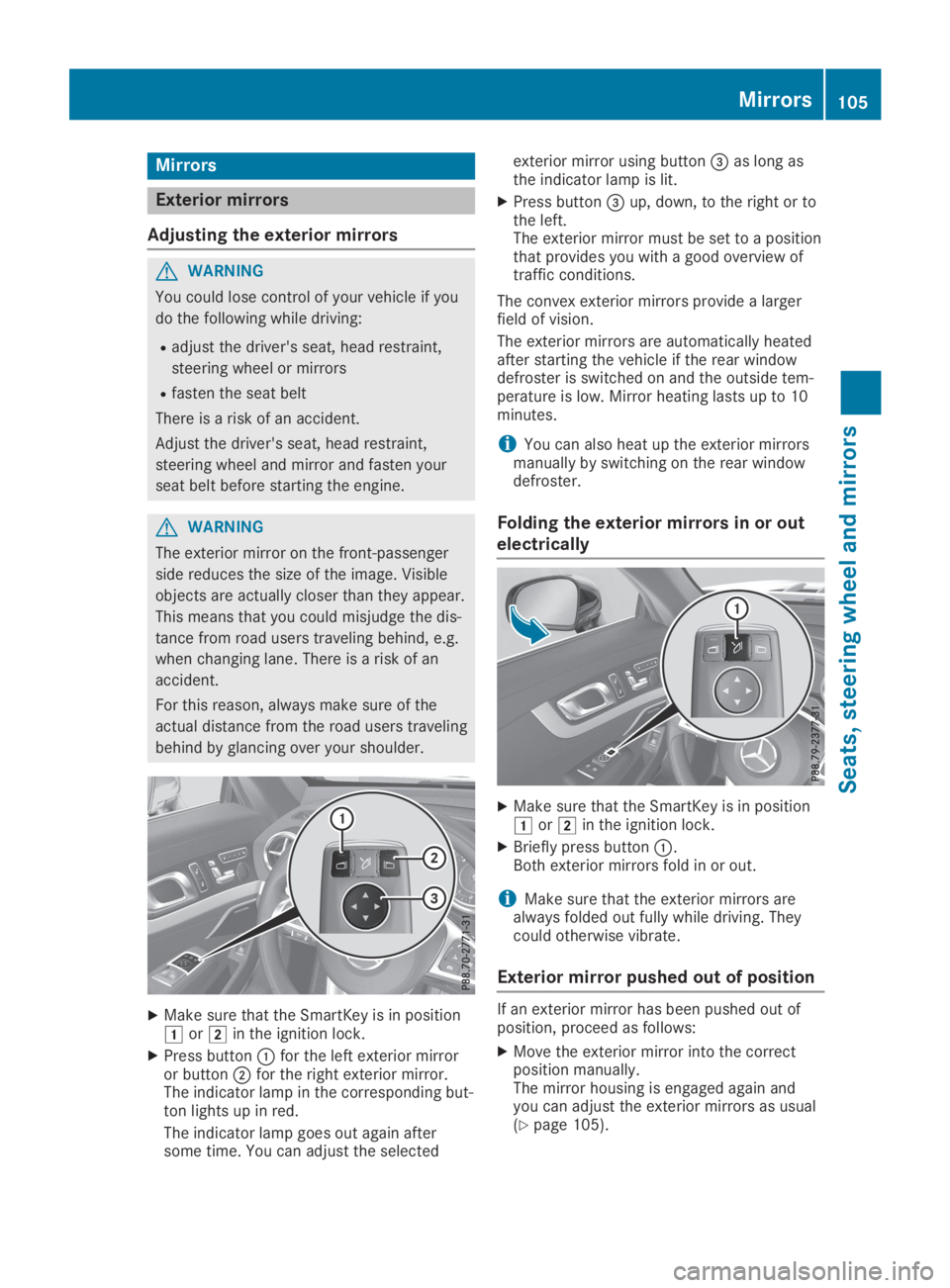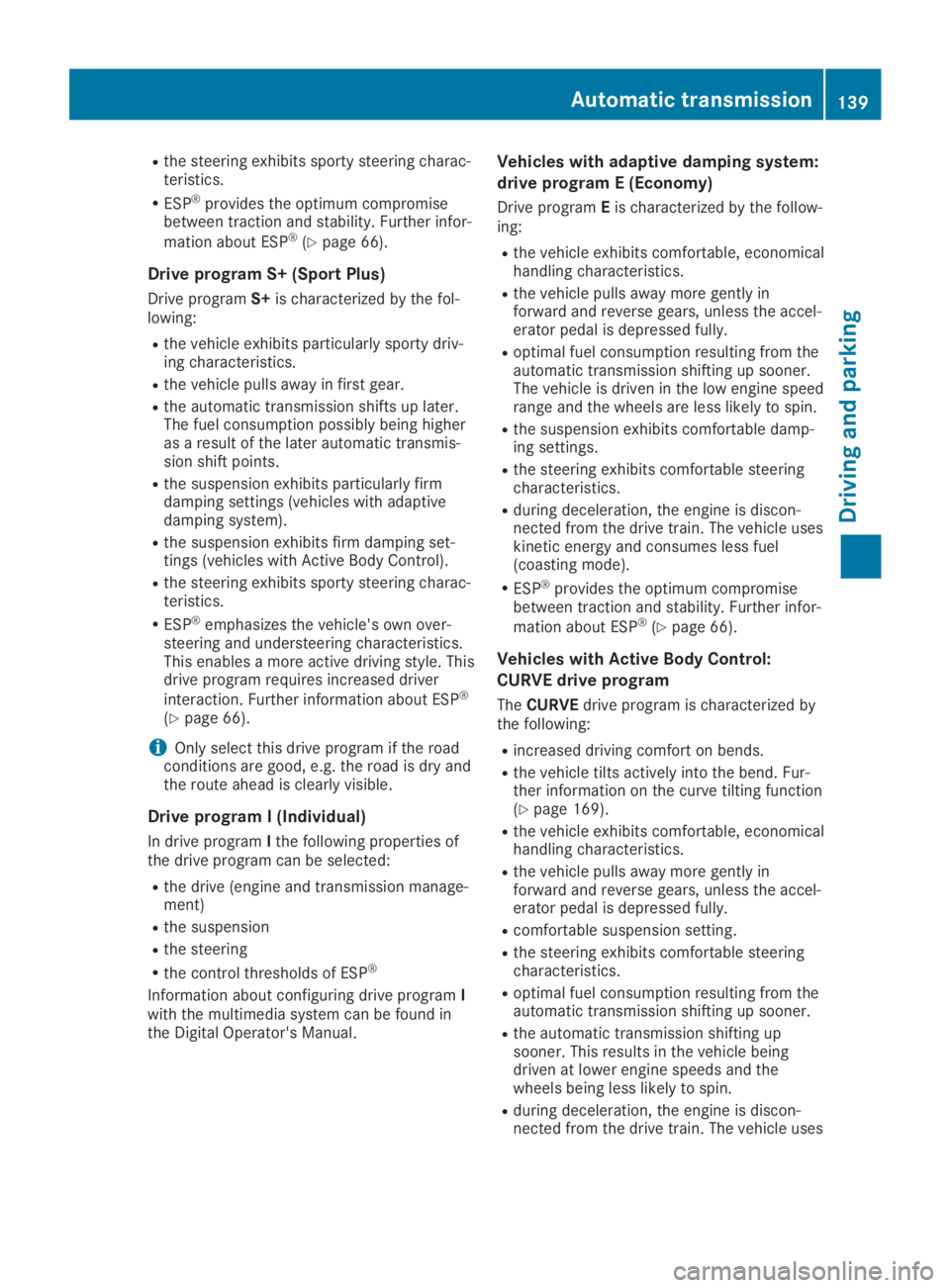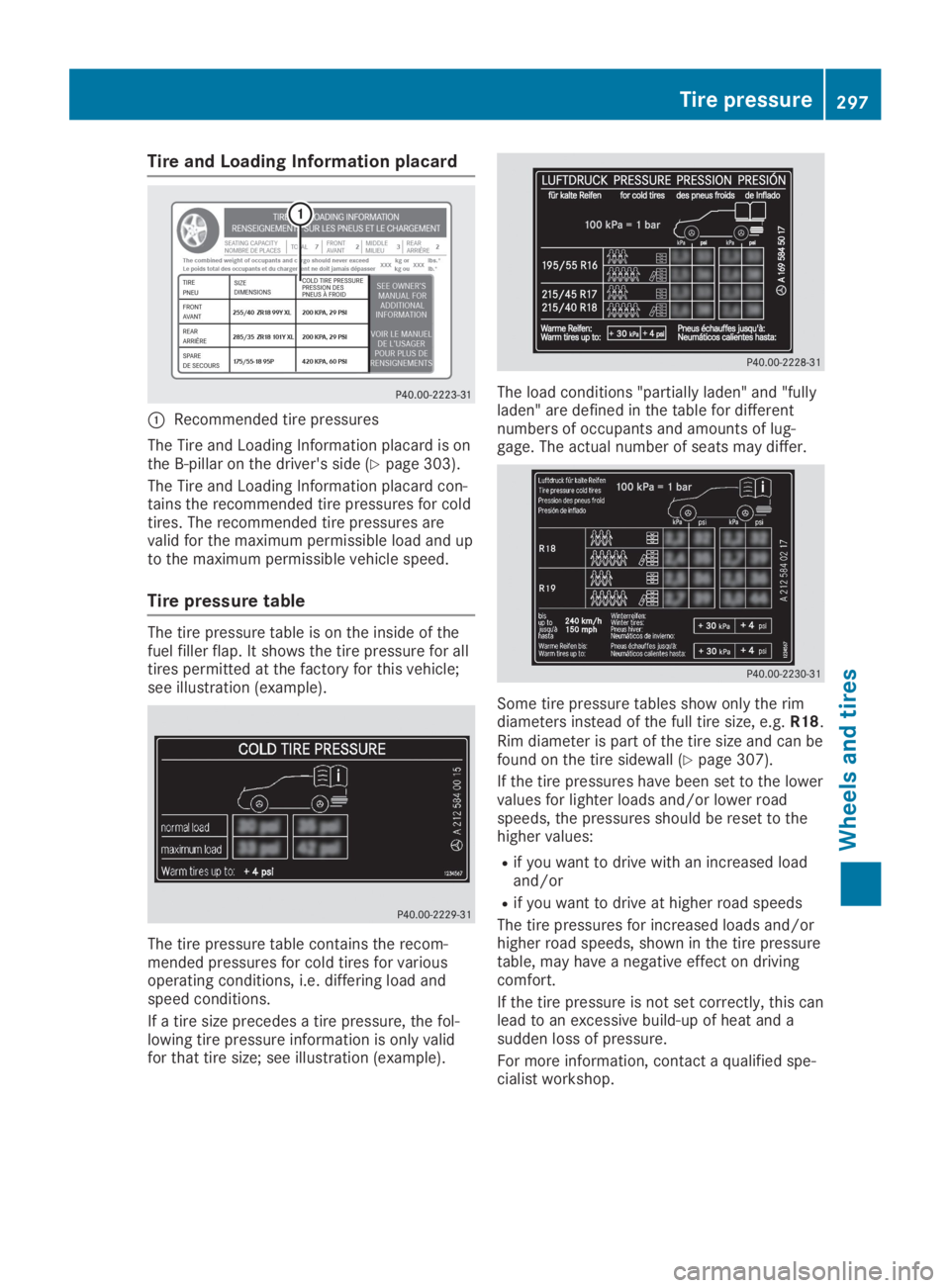2019 MERCEDES-BENZ SL CLASS wheel size
[x] Cancel search: wheel sizePage 22 of 330

Labeling (overview) ........................ 307
Load bearing index (definition) ...... 312
Load index .....................................309
Load index (definition) ................... 312
M+S tires ....................................... 295
Maximum load on a tire (defini-
tion) ............................................... 312
Maximum loaded vehicle weight
(definition) ..................................... 312
Maximum permissible tire pres-
sure (definition) .............................312
Maximum tire load ......................... 310
Maximum tire load (definition) ....... 312
MOExtended tires .......................... 295
Optional equipment weight (defi-
nition) ............................................ 312
Overview ........................................ 293
PSI (pounds per square inch)
(definition) ..................................... 312
Replacing ....................................... 313
Service life ..................................... 294
Sidewall (definition) ....................... 312
Speed rating (definition) ................ 311
Storing ...........................................313
Structure and characteristics
(definition) ..................................... 311
Summer tires ................................. 295
Temperature .................................. 307
TIN (Tire Identification Number)
(definition) ..................................... 312
Tire bead (definition) ......................312
Tire pressure (definition) ................ 312
Tire pressures (recommended) ...... 311
Tire size (data) ............................... 318
Tire size designation, load-bear-
ing capacity, speed rating .............. 307
Tire tread ....................................... 294
Tire tread (definition) ..................... 312
Total load limit (definition) ............. 313
Traction ......................................... 306
Traction (definition) ....................... 312
Tread wear..................................... 306
Uniform Tire Quality Grading
Standards ...................................... 306
Uniform Tire Quality Grading
Standards (definition) .................... 311
Wear indicator (definition) ............. 313
Wheel and tire combination ........... 318
Wheel rim (definition) .................... 311
see Flat tire
Tow-starting
Emergency engine starting ............ 290
Important safety notes .................. 288
Towing
Permitted towing methods ............ 289
Towing away
Important safety guidelines ........... 288
Installing the towing eye ................ 288
Removing the towing eye ............... 289
Transporting the vehicle ................ 290
With both axles on the ground ....... 289
With the rear axle raised ................ 290
Traffic reports
see also Digital Operator's Man-
ual .................................................. 243
Traffic Sign Assist
Display message ............................ 222
Transmission
Overview of transmission posi-
tions .............................................. 134
Selector lever ................................ 134
see Automatic transmission
Transmission position display......... 135
Transporting the vehicle.................. 290
Trip computer (on-board com-
puter).................................................. 193
Trip odometer
Calling up ....................................... 193
Resetting (on-board computer) ...... 194
Trunk
Emergency release .......................... 86
Important safety notes .................... 81
Locking separately ........................... 86
Opening/closing (automatically
from inside) ...................................... 85
Opening/closing (automatically
from outside) ................................... 83
Opening/closing (from outside,
HANDS-FREE ACCESS) .................... 84
Opening/closing (manually from
outside) ............................................ 82
Overview .......................................... 81
Power closing .................................. 81
Trunk lid
Display message ............................ 230
Opening dimensions ...................... 326
20Index
Page 24 of 330

Seat belt ........................................ 233
SPORT handling mode ................... 238
Tire pressure monitor .................... 242
Warning triangle................................ 276
Warranty.............................................. 25
Washer fluid
Display message ............................ 231
Weather display (COMAND)
see also Digital Operator's Man-
ual .................................................. 243
Wheel and tire combinations
Tires ............................................... 318
Wheel bolt tightening torque........... 317
Wheel chock...................................... 314
Wheels
Changing a wheel .......................... 313
Checking ........................................ 293
Cleaning ......................................... 274
Important safety notes .................. 293
Information on driving .................... 293
Interchanging/changing ................ 313
Mounting a new wheel ................... 316
Mounting a wheel .......................... 313
Overview ........................................ 293
Removing a wheel .......................... 316
Storing ........................................... 313
Tightening torque ........................... 317
Wheel size/tire size ....................... 318
Wind screen
Electrical wind screen ...................... 94
Windows
see Side windows
Windshield
Defrosting ...................................... 120
Windshield washer fluid
see Windshield washer system
Windshield washer system
Adding washer fluid ....................... 268
Important safety notes .................. 325
Windshield wipers
Display message ............................ 231
Problem (malfunction) ................... 115
Replacing the wiper blades ............ 114
Switching on/off........................... 113
Winter driving
Important safety notes .................. 295
Slippery road surfaces ................... 153
Snow chains .................................. 295
Winter operation
Overview ........................................ 295
Winter tires
M+S tires....................................... 295
Wiper blades
Cleaning ......................................... 274
Important safety notes .................. 114
Replacing ....................................... 114
Workshop
see Qualified specialist workshop
Z
ZONE function
Switching on/off........................... 120
22Index
Page 69 of 330

Drive programESP®modeCharacteristics
CComfort
EEconomy
ESP®onThis drive program offers the best compromisebetween traction and stability.
Select drive programEorCin difficult roadconditions such as snow and ice or on wetroads.
SSportESP®onThis drive program offers the best compromisebetween traction and stability.
S+Sport PlusESP®SportThe vehicle's own oversteering and understeer-ing characteristics are emphasized. This ena-bles a more active driving style.
This drive program requires increased driverinteraction.
Select this drive program only when road con-ditions are good, e.g. the roads are dry and theroute is clear.
Always adapt your driving style and drive program to the prevailing road and weather conditions.
Additional information for drive programs (Ypage 138).
ECO start/stop function
The ECO start/stop function switches theengine off automatically when the vehiclestops moving. The engine starts automaticallywhen the driver wants to pull away again.
ESP®remains in its previously selected status,
e.g. if ESP®was deactivated before the enginewas automatically switched off.
Deactivating/activating ESP®(except
Mercedes‑AMG vehicles)
Important safety notes
iObserve the "Important safety notes" sec-tion (Ypage 60).
You can select between the following states of
ESP®:
RESP®is activated
RESP®is deactivated
GWARNING
If you deactivate ESP®, ESP®no longer sta-
bilizes the vehicle. There is an increased risk
of skidding and an accident.
Only deactivate ESP®in the situations
described in the following.
It may be best to deactivate ESP®in the fol-lowing situations:
Rwhen using snow chains
Rin deep snow
Ron sand or gravel
Spinning the wheels results in a cutting actionwhich provides better grip.
iActivate ESP®as soon as the situations
described above no longer apply. ESP®willotherwise not be able to stabilize the vehicleif the vehicle starts to skid or a wheel startsto spin.
!Avoid spinning the driven wheels for an
extended period with ESP®deactivated. Youcould otherwise damage the drivetrain.
Driving safety systems67
Safety
Z
Page 107 of 330

Mirrors
Exterior mirrors
Adjusting the exterior mirrors
GWARNING
You could lose control of your vehicle if you
do the following while driving:
Radjust the driver's seat, head restraint,
steering wheel or mirrors
Rfasten the seat belt
There is a risk of an accident.
Adjust the driver's seat, head restraint,
steering wheel and mirror and fasten your
seat belt before starting the engine.
GWARNING
The exterior mirror on the front-passenger
side reduces the size of the image. Visible
objects are actually closer than they appear.
This means that you could misjudge the dis-
tance from road users traveling behind, e.g.
when changing lane. There is a risk of an
accident.
For this reason, always make sure of the
actual distance from the road users traveling
behind by glancing over your shoulder.
XMake sure that the SmartKey is in position�Gor�Hin the ignition lock.
XPress button�Cfor the left exterior mirroror button�Dfor the right exterior mirror.The indicator lamp in the corresponding but-ton lights up in red.
The indicator lamp goes out again aftersome time. You can adjust the selected
exterior mirror using button�
Page 141 of 330

Rthe steering exhibits sporty steering charac-teristics.
RESP®provides the optimum compromisebetween traction and stability. Further infor-
mation about ESP®(Ypage 66).
Drive program S+ (Sport Plus)
Drive programS+is characterized by the fol-lowing:
Rthe vehicle exhibits particularly sporty driv-ing characteristics.
Rthe vehicle pulls away in first gear.
Rthe automatic transmission shifts up later.The fuel consumption possibly being higheras a result of the later automatic transmis-sion shift points.
Rthe suspension exhibits particularly firmdamping settings (vehicles with adaptivedamping system).
Rthe suspension exhibits firm damping set-tings (vehicles with Active Body Control).
Rthe steering exhibits sporty steering charac-teristics.
RESP®emphasizes the vehicle's own over-steering and understeering characteristics.This enables a more active driving style. Thisdrive program requires increased driver
interaction. Further information about ESP®
(Ypage 66).
iOnly select this drive program if the roadconditions are good, e.g. the road is dry andthe route ahead is clearly visible.
Drive program I (Individual)
In drive programIthe following properties ofthe drive program can be selected:
Rthe drive (engine and transmission manage-ment)
Rthe suspension
Rthe steering
Rthe control thresholds of ESP®
Information about configuring drive programIwith the multimedia system can be found inthe Digital Operator's Manual.
Vehicles with adaptive damping system:
drive program E (Economy)
Drive programEis characterized by the follow-ing:
Rthe vehicle exhibits comfortable, economicalhandling characteristics.
Rthe vehicle pulls away more gently inforward and reverse gears, unless the accel-erator pedal is depressed fully.
Roptimal fuel consumption resulting from theautomatic transmission shifting up sooner.The vehicle is driven in the low engine speedrange and the wheels are less likely to spin.
Rthe suspension exhibits comfortable damp-ing settings.
Rthe steering exhibits comfortable steeringcharacteristics.
Rduring deceleration, the engine is discon-nected from the drive train. The vehicle useskinetic energy and consumes less fuel(coasting mode).
RESP®provides the optimum compromisebetween traction and stability. Further infor-
mation about ESP®(Ypage 66).
Vehicles with Active Body Control:
CURVE drive program
TheCURVEdrive program is characterized bythe following:
Rincreased driving comfort on bends.
Rthe vehicle tilts actively into the bend. Fur-ther information on the curve tilting function(Ypage 169).
Rthe vehicle exhibits comfortable, economicalhandling characteristics.
Rthe vehicle pulls away more gently inforward and reverse gears, unless the accel-erator pedal is depressed fully.
Rcomfortable suspension setting.
Rthe steering exhibits comfortable steeringcharacteristics.
Roptimal fuel consumption resulting from theautomatic transmission shifting up sooner.
Rthe automatic transmission shifting upsooner. This results in the vehicle beingdriven at lower engine speeds and thewheels being less likely to spin.
Rduring deceleration, the engine is discon-nected from the drive train. The vehicle uses
Automatic transmission139
Driving an d parking
Z
Page 280 of 330

Tire-change tool kit
The tire-change tool kit can be found in thestowage well under the trunk floor(Ypage 252).
�CBag containing the tire-changing tools
Bag�Cwith the tire-changing tools contains:
Rjack
Rlug wrench
Ralignment bolt
Rwheel chock
Rgloves
Depending on the equipment, tools requiredfor a wheel change, such as a jack or a lugwrench, are not available in all vehicles. Toolsapproved for your vehicle are available at aqualified specialist workshop.
Flat tire
Preparing the vehicle
Your vehicle may be equipped with:
Rtires with run-flat characteristics(MOExtended tires) (Ypage 278)
Vehicle preparation is not necessary onvehicles with MOExtended tires.
Ra TIREFIT kit (Ypage 277)
Vehicles with the Mercedes-Benz emer-gency call system:in the event of a flat tire,you can contact the Mercedes-Benz emer-gency call system customer center.
Vehicles equipped with MOExtended tires arenot equipped with a TIREFIT kit at the factory.It is therefore recommended that you addition-ally equip your vehicle with a TIREFIT kit if youmount tires that do not feature run-flat charac-teristics, e.g. winter tires. A TIREFIT kit may beobtained from a qualified specialist workshop.
Information on changing and mounting wheels(Ypage 313).
XStop the vehicle on solid, non-slippery andlevel ground, as far away as possible fromtraffic.
XSwitch on the hazard warning lamps.
XSecure the vehicle against rolling away(Ypage 146).
XIf possible, bring the front wheels into thestraight-ahead position.
XSwitch off the engine.
XVehicles without KEYLESS-GO:removethe SmartKey from the ignition lock.
XVehicles with KEYLESS-GO:open the driv-er's door.The vehicle electronics are now in position�Z. This is the same as the SmartKey havingbeen removed.
XVehicles with KEYLESS-GO:remove theStart/Stop button from the ignition lock(Ypage 126).
XMake sure that the passengers are notendangered as they do so. Make sure thatno one is near the danger area while awheel is being changed. Anyone who is notdirectly assisting in the wheel changeshould, for example, stand behind the bar-rier.
XGet out of the vehicle. Pay attention to traf-fic conditions when doing so.
XClose the driver's door.
MOExtended tires (tires with run-flat
properties)
General notes
With MOExtended tires (tires with run flatcharacteristics), you can continue to drive yourvehicle even if there is a total loss of pressurein one or more tires. The affected tire must notshow any clearly visible damage.
You can recognize an MOExtended tire by theMOExtended marking which appears on thesidewall of the tire. You will find this markingnext to the tire size designation, the load-bear-ing capacity and the speed index(Ypage 307).
MOExtended tires may only be used in con-junction with an active tire pressure monitor.
278Flat tire
Breakdown assistance
Page 299 of 330

Tire and Loading Information placard
�CRecommended tire pressures
The Tire and Loading Information placard is onthe B-pillar on the driver's side (Ypage 303).
The Tire and Loading Information placard con-tains the recommended tire pressures for coldtires. The recommended tire pressures arevalid for the maximum permissible load and upto the maximum permissible vehicle speed.
Tire pressure table
The tire pressure table is on the inside of thefuel filler flap. It shows the tire pressure for alltires permitted at the factory for this vehicle;see illustration (example).
The tire pressure table contains the recom-mended pressures for cold tires for variousoperating conditions, i.e. differing load andspeed conditions.
If a tire size precedes a tire pressure, the fol-lowing tire pressure information is only validfor that tire size; see illustration (example).
The load conditions "partially laden" and "fullyladen" are defined in the table for differentnumbers of occupants and amounts of lug-gage. The actual number of seats may differ.
Some tire pressure tables show only the rimdiameters instead of the full tire size, e.g.R18.Rim diameter is part of the tire size and can befound on the tire sidewall (Ypage 307).
If the tire pressures have been set to the lowervalues for lighter loads and/or lower roadspeeds, the pressures should be reset to thehigher values:
Rif you want to drive with an increased loadand/or
Rif you want to drive at higher road speeds
The tire pressures for increased loads and/orhigher road speeds, shown in the tire pressuretable, may have a negative effect on drivingcomfort.
If the tire pressure is not set correctly, this canlead to an excessive build-up of heat and asudden loss of pressure.
For more information, contact a qualified spe-cialist workshop.
Tire pressure297
Wheels and tires
Z
Page 302 of 330

Important safety notes
GWARNING
Each tire, including the spare (if provided),
should be checked at least once a month
when cold and inflated to the pressure rec-
ommended by the vehicle manufacturer on
the Tire and Loading Information placard on
the driver's door B-pillar or the tire pressure
label on the inside of the fuel filler flap. If
your vehicle has tires of a different size than
the size indicated on the Tire and Loading
Information placard or the tire pressure
label, you should determine the proper tire
pressure for those tires.
As an added safety feature, your vehicle has
been equipped with a tire pressure monitor-
ing system (TPMS) that illuminates a low tire
pressure telltale when one or more of your
tires are significantly underinflated. Accord-
ingly, when the low tire pressure telltale illu-
minates, you should stop and check your
tires as soon as possible, and inflate them to
the proper pressure. Driving on a signifi-
cantly underinflated tire causes the tire to
overheat and can lead to tire failure. Under-
inflation also reduces fuel efficiency and tire
tread life, and may affect the vehicle's han-
dling and stopping ability.
Please note that the TPMS is not a substi-
tute for proper tire maintenance, and it is
the driver's responsibility to maintain cor-
rect tire pressure, even if underinflation has
not reached the level to trigger illumination
of the TPMS low tire pressure telltale.
USA only:
Your vehicle has also been equipped with a
TPMS malfunction indicator to indicate if the
system is not operating properly. The TPMS
malfunction indicator is combined with the
low tire pressure telltale. When the system
detects a malfunction, the warning lamp will
flash for approximately a minute and then
remain continuously illuminated. This
sequence will be repeated every time the
vehicle is started as long as the malfunction
exists.
When the malfunction indicator is illumina-
ted, the system may not be able to detect or
signal low tire pressure as intended. TPMS
malfunctions may occur for a variety of rea-
sons, including the mounting of incompati-
ble replacement or alternate tires or wheels
on the vehicle that prevent the TPMS from
functioning properly. Always check the
TPMS malfunction telltale after replacing
one or more tires or wheels on your vehicle
to ensure that the replacement or alternate
tires and wheels allow the TPMS to continue
to function properly.
It is the driver's responsibility to set the tirepressure to that recommended for cold tireswhich is suitable for the operating situation(Ypage 296). Note that the correct tire pres-sure for the current operating situation mustfirst be taught-in to the tire pressure monitor.If a substantial loss of pressure occurs, thewarning threshold for the warning message isaligned to the taught-in reference values.Restart the tire pressure monitor after adjust-ing the pressure of the cold tires(Ypage 301). The current pressures aresaved as new reference values. As a result, awarning message will appear if the tire pres-sure drops significantly.
The tire pressure monitor does not warn you ofan incorrectly set tire pressure. Observe thenotes on the recommended tire pressure(Ypage 296).
The tire pressure monitor is not able to warnyou of a sudden loss of pressure, e.g. if thetire is penetrated by a foreign object. In theevent of a sudden loss of pressure, bring thevehicle to a halt by braking carefully. Avoidabrupt steering movements.
The tire pressure monitor has a yellow warninglamp in the instrument cluster for indicatingpressure loss or a malfunction. Whether thewarning lamp flashes or lights up indicateswhether a tire pressure is too low or the tirepressure monitor is malfunctioning:
Rif the warning lamp is lit continuously, thetire pressure on one or more tires is signifi-cantly too low. The tire pressure monitor isnot malfunctioning.
Rif the warning lamp flashes for approx-imately a minute and then remains lit con-
300Tire pressure
Wheels and ti res